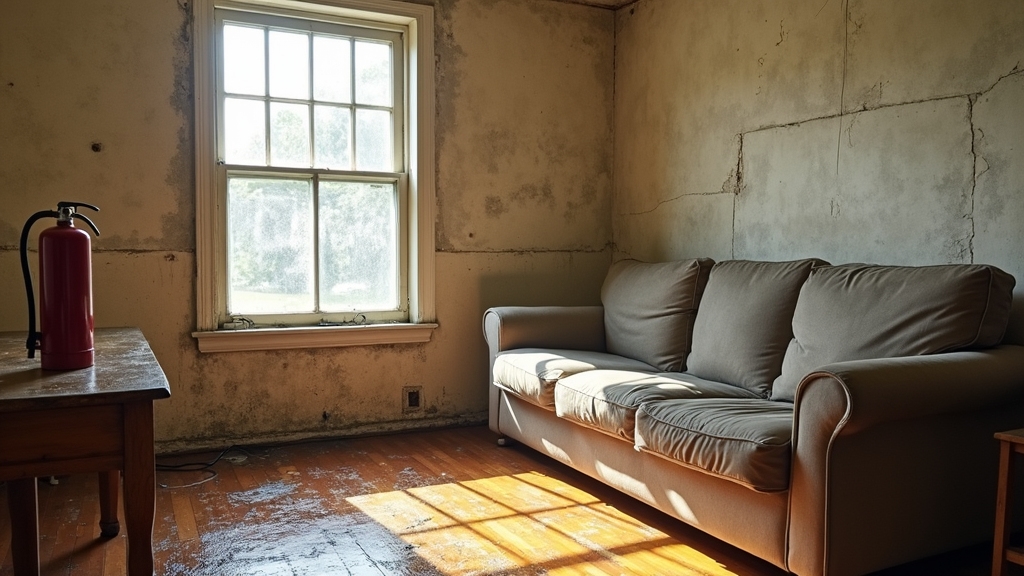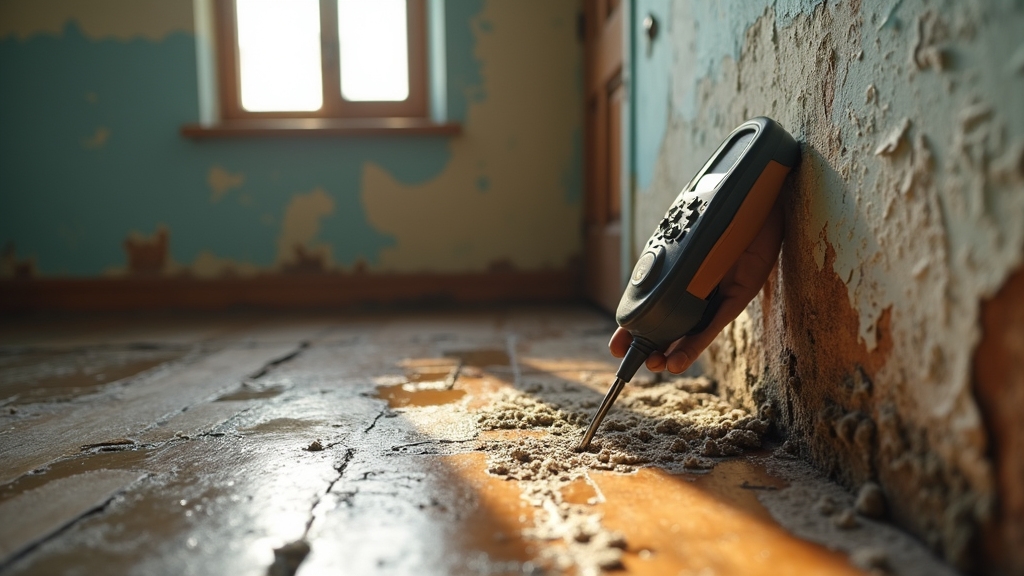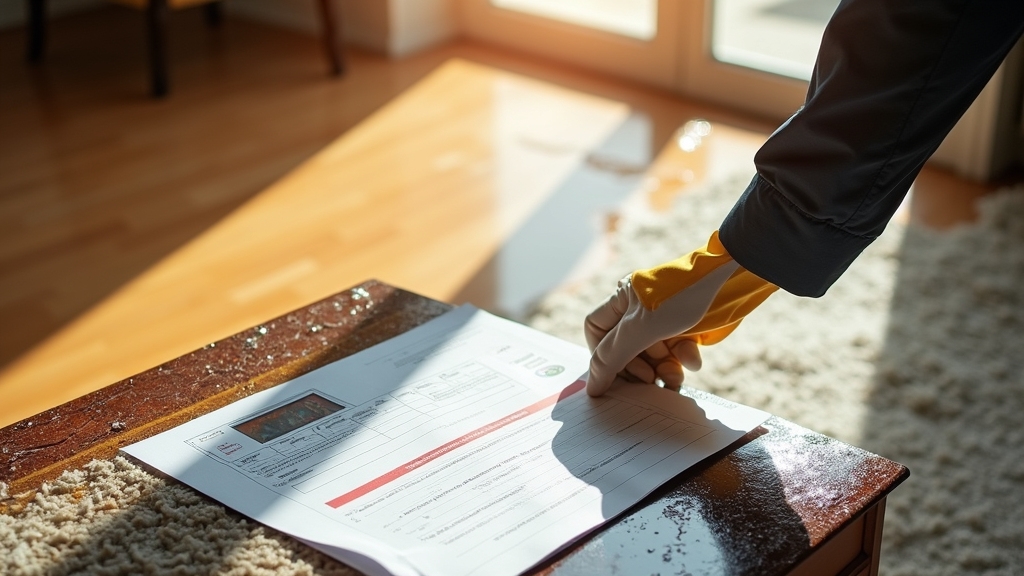Selling a house with water damage can be complicated and stressful. Many homeowners worry about what costs their insurance will cover. Not knowing the details can lead to surprises and delays when you try to sell.
Buyers may lose trust if damage is not handled well. You could face lower offers or legal trouble if repairs are not done right. Insurance claims can also get denied if the damage is from long-term neglect.
Home insurance usually covers sudden and accidental water damage, but not damage from neglect or gradual leaks. Knowing what is covered helps you plan repairs and build buyer confidence.
Clear documentation and honest disclosure will protect you during the sale. This blog will guide you through home insurance coverage, repairs, and how to sell a water-damaged house smoothly.
Understanding Water Damage Types and Their Impact on Coverage

Home insurance treats water damage differently based on its source. Sudden and accidental water damage is usually covered. Gradual issues from poor maintenance are often not covered.
A burst pipe is a common example of covered damage. If you ignore a slow leak, your claim may be denied. Insurers expect homeowners to address small problems quickly. Proper maintenance can help prevent many water-related issues and protect your coverage.
You should always document any water damage events. Records of repairs and maintenance can help support your claim. Regular inspections and fast repairs can protect your coverage.
Knowing these rules helps you avoid problems when selling a water-damaged home. Good maintenance reduces risk and prevents surprises. If you take care of your property, you are more likely to stay protected. Proper understanding of water damage types can also align with insurance claim strategies to maximize your coverage.
Common Sources of Water Damage in Homes
Most water damage in homes comes from a few common sources. Flooded basements often happen after heavy rain or fast snowmelt. Poor drainage, foundation cracks, or failed sump pumps let water in.
Proper drainage systems can significantly reduce the risk of basement flooding and water damage. Flooded basements are a common problem after heavy rain or rapid snowmelt, often caused by poor drainage or foundation issues.
Leaking pipes are a big problem, especially if pipes are old or freeze and thaw. These leaks can hide behind walls or ceilings and cause damage over time. If you notice stains or mold, there may be a hidden leak.
Home appliances can also cause water damage if they break. Water heaters, dishwashers, and washing machines sometimes leak onto the floor. Regular checks can help catch issues early.
Roof leaks are another source, often due to damaged shingles or blocked gutters. If you see water spots on ceilings, check your roof. Fixing small problems early can prevent bigger repairs later.
Additionally, water damage prevention methods such as installing leak detection systems can help identify issues before they cause significant harm.
Standard Home Insurance Policies: What’s Typically Covered

Standard home insurance usually covers sudden and accidental water damage. It often pays for repairs to your home and belongings. Quick action is needed to prevent further issues. Being aware of property types and conditions that might affect coverage is also important. You must report any home upgrades or changes to your insurer. Failure to do this could leave your new improvements underinsured.
Always keep your insurance company informed about renovations. Water damage can sometimes lead to pest problems. If this happens, arrange pest control right away to avoid more damage. Document all damage and contact your insurer immediately.
Knowing what is covered helps you handle water issues confidently. It also prepares you if you plan to sell your home. Legal documentation such as reports from inspections can support your claim if needed. Clear records and quick responses improve your chances of a smooth claim process.
Exclusions: What Home Insurance Usually Doesn’t Cover
Home insurance does not cover every type of water damage. Damage from poor maintenance, like slow leaks, is usually excluded. If repairs are neglected, your policy will likely not pay out. Home insurance often excludes water damage from slow leaks or poor maintenance, so neglected repairs may not be covered.
Insurers typically do not cover gradual problems or mold from long-term moisture. Damage caused by neglect is also not included. If you fail to fix issues quickly, you may be responsible for the costs.
Your property must meet local building codes for claims to be valid. If codes are ignored, insurance may deny your claim. Property taxes do not affect your insurance coverage.
Always check your policy’s exclusions carefully. Regular home maintenance helps prevent uncovered damage. Title search and other property record checks can help identify potential issues that might affect coverage or sale.
The Role of Flood Insurance in Water Damage Claims

You need to understand that home insurance usually won’t cover flood-related water damage, which is where flood insurance becomes essential. Carefully review policy limitations so you’re not caught off guard by exclusions, and know that the claim process for flood damage follows different rules than standard water damage claims. If you live in a flood-prone area, it’s critical to secure separate flood insurance and learn exactly how to file a claim when disaster strikes.
Additionally, understanding water damage coverage can help you navigate the differences in insurance policies more effectively. Recognizing the benefits of cash buyers can also expedite your property sale, especially when dealing with water-damaged homes that might require quick transactions.
Differentiating Flood vs. Water
Flood damage and water damage are not the same for insurance purposes. Floods are usually not covered by standard home insurance. Special flood insurance is needed for protection from floods.
Flood refers to water entering from outside, like heavy rain or rivers. Water damage from burst pipes or roof leaks is different. Homeowner’s insurance usually covers this type of damage.
You should test the water source before making a claim. This helps show if the damage was from a flood or another cause. If you know the difference, you can avoid denied claims and get the right coverage when selling your home.
Policy Coverage Limitations
Home insurance policies have many limits on water damage coverage. They do not cover all types of water damage. Homeowners should know what is not covered.
Most policies exclude damage from floods, groundwater, and poor plumbing maintenance. If you live in a flood zone, you may need separate flood insurance. Insurance will not pay for problems caused by neglect.
Even if water damage is covered, your policy may limit how much it pays. You may have to pay for repairs that cost more than your policy limit. Always check your policy details and talk to your agent about any gaps.
Claim Filing Process
The claim filing process is how you report water damage to your insurance provider. You must know what your policy covers and how to file a claim. This helps you get the support you need.
Start by taking clear photos of all damage. You should keep receipts for repairs and make a list of damaged items. If your policy does not cover floods, contact your flood insurance provider.
Notify your insurance company as soon as possible. Home insurance claims should be filed within 24–48 hours. Flood insurance claims need to be filed immediately after the event.
Your insurance company will ask for evidence like photos and repair estimates. Flood claims often need a detailed list of damaged items and more photos. Coverage may include mold removal, repairs, or replacement of belongings, depending on your policy.
How Pre-Existing Damage Affects Insurance Claims
You need to disclose any pre-existing water damage when filing a claim, as insurers often deny coverage for issues that existed before your policy began. If you try to claim for damage that wasn’t properly repaired or reported, you risk having your entire claim rejected.
Before selling your home, make sure you’ve addressed and documented all repairs, since undisclosed problems can create legal and financial setbacks. Utilizing a cash sale can help you avoid financing delays that might complicate the claims process. Being aware of market fluctuations and timing your sale appropriately can also influence your ability to recover costs associated with water damage.
Disclosure Requirements for Damage
You must tell your insurer about any old damage when you file a water damage claim. If you hide past problems, your claim may be denied. Full honesty at the start makes the process smoother.
Insurers check your property before agreeing to pay. They expect you to mention all past water issues right away. If you wait until later, you could face delays or disputes.
Keep records of repairs, old damage, and maintenance. Showing these documents proves you have nothing to hide. Clear information helps your insurer trust your claim.
Coverage Denials Explained
Insurers deny water damage claims for some homes due to specific rules in your policy. They look at the cause and timing of the damage. If the damage happened before your policy, your claim will likely get denied.
Pre-existing damage is not covered by most insurance policies. Insurers check if the water issue started before coverage began. They will not pay for old problems.
Neglecting maintenance can also lead to denial. If you ignore leaks or broken pipes, insurers can reject your claim. Good property care is important for coverage.
Not telling the insurer about past water issues can void your claim. Always share past incidents when applying for insurance. Honest disclosure helps you avoid surprises.
Keep records of repairs and maintenance. Documentation supports your claim if water damage happens. If you follow these steps, you reduce your risk of denial.
Repair Obligations Before Sale
You must fix all known water damage before selling your home. Buyers and insurers expect issues to be repaired before closing. If repairs are not made, buyers may ask for a lower price or cancel the deal.
A home inspection will likely reveal any water damage. The appraiser will also lower your home’s value if there is damage. Some buyers may not get a loan if the home needs repairs.
Most insurance companies will not pay for old damage. You cannot file a claim for repairs after selling. If you do not disclose problems, you could face legal trouble.
You should share all damage with buyers and fix problems before selling. Always keep records of repairs and show them to buyers. These steps help avoid disputes and make selling easier.
Steps to Take Immediately After Discovering Water Damage
If you find water damage, act quickly to prevent more problems. Fast action helps stop extra damage and keeps mold away. Ignoring water damage can lower your home’s value and safety.
First, stop the water at its main source if you can. Turn off the main valve or fix any leaks right away. This prevents more water from entering your home.
Next, remove any standing water using mops, towels, or a wet/dry vacuum. Work quickly to clear as much water as possible. If you wait, water can soak deeper into floors and walls, making repairs more difficult. Then, help the area dry by opening windows and running fans.
You can use a dehumidifier to remove moisture from the air. This step helps stop mold from growing. Proper drying techniques are essential to prevent future issues. Proper documentation of water damage can help protect your insurance claim if you need to file one later.
Filing a Water Damage Claim: Key Documentation and Procedures
To file a water damage claim, you need good documentation and must follow the correct steps. Start by taking clear photos and videos before doing any repairs. These images prove the extent of the damage to your insurance company.
You should collect receipts for all emergency repairs or services. These receipts help you get reimbursed if your policy covers those costs. If you spot mold or signs of structural issues, document these as well.
Keep a log of every call, email, or letter exchanged with your insurer. This log helps you track your claim’s status. Store all your documentation in one place for easy access during the claims process.
Additionally, reviewing public records can help identify recent property transactions and potential previous damages that might support your claim.
Working With Adjusters: What to Expect During the Inspection
When an insurance adjuster visits, they will inspect your water damage claim. The adjuster checks how much damage occurred and confirms your information. Their report can impact your claim approval and future premiums.
The adjuster will look at all damaged areas and take photos. They check for both visible and hidden water damage in your home. If they find more damage, your repair costs may increase.
You should be ready to explain what happened and when the damage started. The adjuster might ask for maintenance records or receipts. Having documents ready can speed up the inspection.
The adjuster may talk with contractors or experts about repair costs. These discussions help decide the correct amount for your claim. If you prepare, the inspection process will go more smoothly.
Insurance Payouts: How Compensation Is Calculated
When your insurer calculates your payout, they start by determining the actual value of the water damage based on repair or replacement costs. They’ll then subtract your policy’s deductible from that amount, which directly reduces what you receive. To maximize your compensation, make sure you understand how damage is assessed and how your deductible impacts the final figure.
Assessing Damage Value
Insurers use set methods to decide how much your water damage is worth. They do not guess the value but follow industry standards. Knowing their process helps you get the right payout.
An adjuster checks the damage to your home’s walls, floors, and ceilings. If any area is badly affected, you may get a higher payment. The more damage found, the more your claim could be worth.
Material and labor costs in your area also matter. Insurers use current prices to estimate repair or replacement. If prices are high, your payout may increase.
Insurers consider the age and wear of your property items. If something is old, you may get less money for it. Depreciation reduces the amount you receive.
You should take clear photos of all the damage. If you gather repair quotes from licensed contractors, your claim may be stronger. Proper documentation supports your case for fair compensation.
Policy Deductibles Impact
Your policy deductible will lower the payout you get from an approved water damage claim. For example, if your claim is $15,000 and your deductible is $2,000, you will receive $13,000. Always check your policy to understand how deductibles and coverage limits affect your payment.
If you have a high deductible, your insurance payout will be lower. A low deductible means you get more money, but only up to your coverage limit. If your claim is more than your coverage limit, the payment will stop at the limit.
You should compare your deductible to the possible damage costs. A high deductible means you pay more before insurance helps. Careful policy selection can save you money if damage happens.
Making Repairs Before Listing: What Insurance May Pay For
Home insurance may help pay for some repairs before you list your water-damaged house for sale. The policy usually does not cover every type of repair. It is important to know exactly what your insurance will and will not pay for.
Most policies pay to restore your home to its previous condition if the damage is covered. Insurance usually will not cover upgrades or fix old problems that were not caused by the recent water damage. Always read your policy to see what is excluded, such as cosmetic changes or some appliances.
Your insurance may help with three key areas. It may cover repairs to walls, floors, and ceilings damaged by water. The policy might also pay for built-in appliances and repairs to plumbing or electrical systems if the damage was caused by a covered event.
Disclosing Water Damage to Potential Buyers
You must follow strict legal disclosure requirements when selling a home with past water damage, and failure to do so can lead to serious liability. Transparency not only keeps you compliant, but it also impacts your sale price—buyers may negotiate lower offers once they’re aware of previous issues. Make sure you document repairs and communicate clearly to protect your interests throughout the transaction.
Legal Disclosure Requirements
You must tell buyers about water damage when selling your home. Laws in your state or city usually make this a requirement. Not sharing this information can lead to legal trouble or cancel the sale.
Most places need you to fill out a form about past water damage and repairs. Water damage is a material fact and must be revealed, even if repairs were made. You should check the specific rules for your area.
If you have reports, receipts, or insurance claims, you should give copies to the buyer. This helps show you are being honest. Staying clear and open can help you avoid problems later.
Impact on Sale Price
Water damage disclosure almost always lowers a home’s sale price. Buyers are usually cautious if they know about past water problems. Even fully repaired homes face closer inspection and lower offers.
If you disclose water damage, buyers may trust you less. You should provide repair records and explain what was fixed. Transparency can help but may not remove all doubts.
The home’s price often drops between 5% and 15%. If you want to sell, consider adjusting your asking price. This helps attract serious buyers.
Staging a home may not fully hide past issues. You should show areas that were not affected by water. This can help reassure some buyers.
Negotiations may become more difficult. Sellers often need to offer extra concessions to close the deal. If you expect this, you can plan ahead.
Homes with water damage history usually take longer to sell. Setting realistic expectations can make the process less stressful. Being upfront can save time in the long run.
The Impact of Water Damage Claims on Home Value and Saleability
Water damage claims can lower your home’s value and make it harder to sell. Buyers often see these claims as a warning sign. If your home has a water damage history, it could stay on the market longer. Water damage claims often scare off buyers and can keep your home on the market longer, lowering its value.
Buyers may worry about the house’s safety or future repairs. They might offer less money or ask for special inspections. Detailed claim records are available to buyers and may affect their choice.
Sellers must legally share information about past water damage and insurance claims. This disclosure may cause buyers to trust the house less. If you fail to share this, you could face legal problems.
Lenders sometimes refuse loans for homes with many water damage claims. This reduces the number of people who can buy your house. If you have claims, selling your home could take more time and effort.
Tips for Navigating the Sale of a Water-Damaged Property
Selling a house with water damage requires careful planning. You must be honest about all repairs and past issues. Buyers trust you more if you share this information upfront.
Check the home for leftover problems. Roof shingles often show signs of new or old water issues. If you fix these, buyers may feel more comfortable.
Pests can be a problem after water damage. You should hire a professional to check for pests. If your home is pest-free, show buyers proof.
Work with a real estate agent who knows about water-damaged homes. An expert can help you with negotiations and paperwork. This support can lead to a better sale.
Conclusion
If you are selling a water-damaged house, home insurance can help but will not solve every problem. If you document repairs and disclose all issues, you protect yourself and your buyer. If you ignore these steps, you may face legal or financial trouble.
If you want to avoid the hassle, we buy houses for cash, no matter their condition. If you choose this route, you can sell quickly and skip the repairs or waiting for insurance claims. If you want a stress-free sale, this option works well.
If you are ready to move forward, contact Limitless Homes of KC today. We can make you a fair, no-obligation cash offer. Let us help you sell your water-damaged house fast and with confidence.

